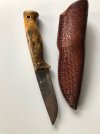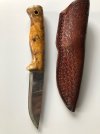Making a puukko from beech from the garden. It's been rested a couple of months so I'm expecting it to still tighten, but given the small diameter it's pretty much handle sized already after trimming the sides into a block. Following lots of online advice for the different bits and bobs: using a bolster and the cheapest Lauri blade I could find. Going for hidden tang rather than getting the tang through the back and penning it against the handle. I'll rest the block a couple of days between making the hole for the tang and fixing the blade with epoxy it's still drying.
Note: I only have hand tools and I'm happy with something far from perfect. I can rasp and sand pretty well, though. Making a knife press over the weekend too. Expectations are low
Note: I only have hand tools and I'm happy with something far from perfect. I can rasp and sand pretty well, though. Making a knife press over the weekend too. Expectations are low



